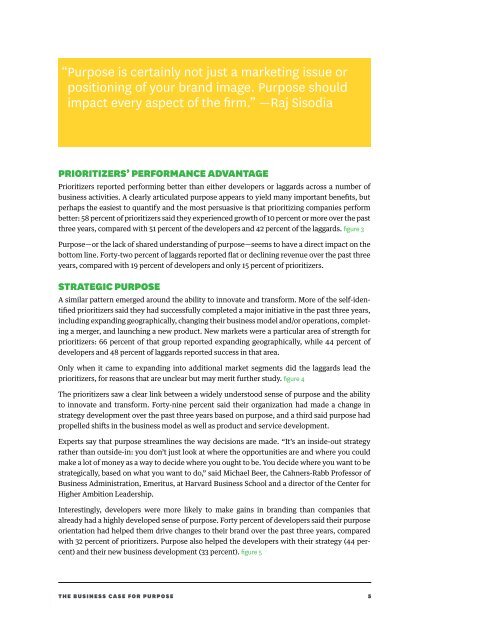FOR PURPOSE
ebuvFR2
ebuvFR2
Create successful ePaper yourself
Turn your PDF publications into a flip-book with our unique Google optimized e-Paper software.
“Purpose is cer tainly not just a marketing issue or<br />
positioning of your brand image. Purpose should<br />
impact every aspect of the firm.” —Raj Sisodia<br />
PRIORITIZERS’ PER<strong>FOR</strong>MANCE ADVANTAGE<br />
Prioritizers reported performing better than either developers or laggards across a number of<br />
business activities. A clearly articulated purpose appears to yield many important benefits, but<br />
perhaps the easiest to quantify and the most persuasive is that prioritizing companies perform<br />
better: 58 percent of prioritizers said they experienced growth of 10 percent or more over the past<br />
three years, compared with 51 percent of the developers and 42 percent of the laggards. figure 3<br />
Purpose—or the lack of shared understanding of purpose—seems to have a direct impact on the<br />
bottom line. Forty-two percent of laggards reported flat or declining revenue over the past three<br />
years, compared with 19 percent of developers and only 15 percent of prioritizers.<br />
STRATEGIC <strong>PURPOSE</strong><br />
A similar pattern emerged around the ability to innovate and transform. More of the self-identified<br />
prioritizers said they had successfully completed a major initiative in the past three years,<br />
including expanding geographically, changing their business model and/or operations, completing<br />
a merger, and launching a new product. New markets were a particular area of strength for<br />
prioritizers: 66 percent of that group reported expanding geographically, while 44 percent of<br />
developers and 48 percent of laggards reported success in that area.<br />
Only when it came to expanding into additional market segments did the laggards lead the<br />
prioritizers, for reasons that are unclear but may merit further study. figure 4<br />
The prioritizers saw a clear link between a widely understood sense of purpose and the ability<br />
to innovate and transform. Forty-nine percent said their organization had made a change in<br />
strategy development over the past three years based on purpose, and a third said purpose had<br />
propelled shifts in the business model as well as product and service development.<br />
Experts say that purpose streamlines the way decisions are made. “It’s an inside-out strategy<br />
rather than outside-in: you don’t just look at where the opportunities are and where you could<br />
make a lot of money as a way to decide where you ought to be. You decide where you want to be<br />
strategically, based on what you want to do,” said Michael Beer, the Cahners-Rabb Professor of<br />
Business Administration, Emeritus, at Harvard Business School and a director of the Center for<br />
Higher Ambition Leadership.<br />
Interestingly, developers were more likely to make gains in branding than companies that<br />
already had a highly developed sense of purpose. Forty percent of developers said their purpose<br />
orientation had helped them drive changes to their brand over the past three years, compared<br />
with 32 percent of prioritizers. Purpose also helped the developers with their strategy (44 percent)<br />
and their new business development (33 percent). figure 5<br />
THE BUSINESS CASE <strong>FOR</strong> <strong>PURPOSE</strong> 5


